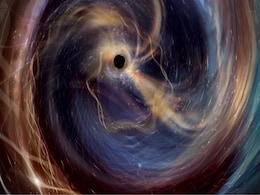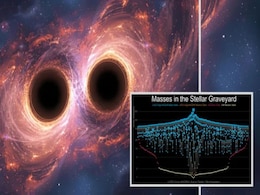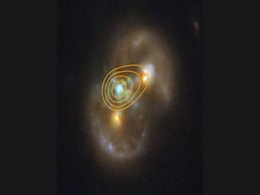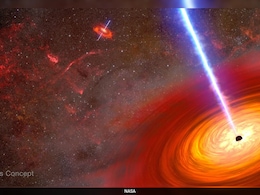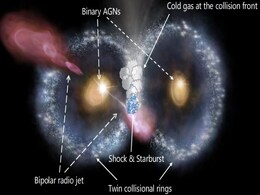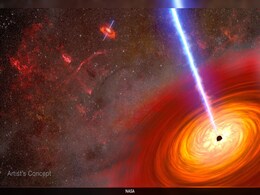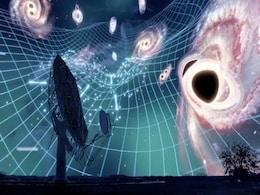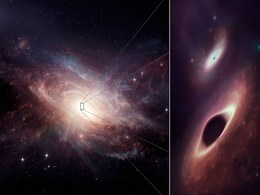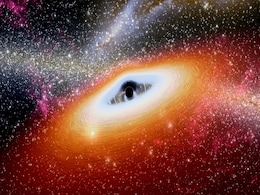Black Holes Collision
- All
- News
-

Rare ‘Second-Generation’ Black Holes Detected, Proving Einstein Right Again
- Friday October 31, 2025
- Written by Gadgets 360 Staff
Scientists have detected two unusual black hole mergers showing signs of “second-generation” origins — meaning each large black hole likely formed from an earlier merger. The gravitational-wave signals also matched Einstein’s predictions on spinning black holes, offering fresh proof of general relativity and new insights into how black hole...
-
 www.gadgets360.com
www.gadgets360.com
-

LIGO Detect Possible Second-Generation Black Holes with Extreme Spins
- Sunday November 2, 2025
- Written by Gadgets 360 Staff
LIGO-Virgo-KAGRA observatories detected two extraordinary black hole collisions in late 2024—GW241011 and GW241110. The first involved a rapidly spinning black hole, while the second revealed one rotating opposite its orbit. These findings fit predictions for second-generation black holes, born from earlier mergers within crowded star clusters. T...
-
 www.gadgets360.com
www.gadgets360.com
-

Astronomers Discover Stellar Graveyard Filled With Black Hole and Neutron Star Collisions
- Friday September 5, 2025
- Written by Gadgets 360 Staff
Astronomers using LIGO-Virgo-KAGRA detected 128 collisions of black holes and neutron stars, including two rare mixed mergers that double previous records. These findings reveal new details of stellar evolution, refine Hubble constant estimates, and test Einstein’s relativity in extreme conditions. The cosmic “graveyard” offers fresh insight ...
-
 www.gadgets360.com
www.gadgets360.com
-

JWST Finds Black Hole Between Galaxy Cores, Hinting at Rare Direct Collapse Birth
- Thursday July 17, 2025
- Written by Gadgets 360 Staff
Using JWST, astronomers discovered a black hole between two galaxy cores in the Infinity Galaxy—possibly the first direct evidence of a black hole formed by gas collapse, not stellar death. This rare “heavy seed” black hole challenges standard models and could help explain how supermassive black holes appeared so soon after the Big Bang.
-
 www.gadgets360.com
www.gadgets360.com
-

James Webb Telescope Spots Rare ‘Cosmic Owl’ Formed by Colliding Galaxies
- Monday July 14, 2025
- Written by Gadgets 360 Staff
NASA’s James Webb Space Telescope has unveiled the “Cosmic Owl,” a jaw-dropping image of two colliding ring galaxies forming a structure that resembles an owl’s face. This double-ring formation is extraordinarily rare, and the event is shedding light on galaxy evolution, black hole dynamics, and rapid star formation. Led by Ph.D. student Mi...
-
 www.gadgets360.com
www.gadgets360.com
-

Most Distant Mini-Halo Discovered in Galaxy Cluster 10 Billion Light-Years Away
- Monday June 30, 2025
- Written by Gadgets 360 Staff
Astronomers have uncovered the most distant mini-halo ever detected, located around the galaxy cluster SpARCS1049, a staggering 10 billion light-years from Earth. Using the LOFAR radio telescope network, which spans eight European countries, researchers detected a faint, diffuse glow—evidence of a giant cloud of high-energy particles and magnetic...
-
 www.gadgets360.com
www.gadgets360.com
-

When Two Massive Black Holes Merged And Went Flying Across Cosmos
- Sunday March 9, 2025
- Science | Edited by Anjali Thakur
The researchers propose that this ejection resulted from the collision of two galaxies, causing their central black holes to merge into a larger one.
-
 www.ndtv.com
www.ndtv.com
-

Gravitational Waves Reveal Black Hole Ancestry Through Spin Analysis
- Monday February 3, 2025
- Written by Gadgets 360 Staff
A study published in Physical Review Letters explores how gravitational waves reveal the ancestry of black holes. By examining 69 black hole mergers, researchers found that spin shifts indicate repeated collisions in dense star clusters. This insight supports models suggesting black holes grow through sequential mergers. Observatories like LIGO and...
-
 www.gadgets360.com
www.gadgets360.com
-

MeerKAT Detects Gravitational Wave Background, Uncovering Cosmic Activity
- Friday December 27, 2024
- Written by Gadgets 360 Staff
Scientists using the MeerKAT Pulsar Timing Array have made a groundbreaking discovery, confirming the presence of a gravitational wave background in the universe. This unexpected phenomenon, detected with unprecedented precision, suggests that supermassive black hole collisions may occur more frequently than previously thought. By observing the sig...
-
 www.gadgets360.com
www.gadgets360.com
-

NASA's Hubble and Chandra Telescopes Spot Strange Tilted Black Hole
- Tuesday December 24, 2024
- Written by Gadgets 360 Staff
NASA’s Hubble and Chandra telescopes have uncovered a bizarre sideways black hole in the galaxy NGC 5084, located 80 million light-years away. The black hole’s unexpected tilt suggests it may have been influenced by a violent galactic collision. A new image processing technique, SAUNAS, revealed X-ray plumes in the galaxy, hinting at a cosmic e...
-
 www.gadgets360.com
www.gadgets360.com
-

Hubble and Chandra Telescopes Spot Strange Tilted Black Hole in Galaxy NGC 5084
- Tuesday December 24, 2024
- Written by Gadgets 360 Staff
NASA’s Hubble and Chandra telescopes have uncovered a bizarre sideways black hole in the galaxy NGC 5084, located 80 million light-years away. The black hole’s unexpected tilt suggests it may have been influenced by a violent galactic collision. A new image processing technique, SAUNAS, revealed X-ray plumes in the galaxy, hinting at a cosmic e...
-
 www.gadgets360.com
www.gadgets360.com
-

Black Hole Mergers Explained: What Happens When Two Black Holes Collide in Space?
- Tuesday October 22, 2024
- Written by Gadgets 360 Staff
Black hole mergers are among the most energetic events in space. Two black holes gradually lose energy through gravitational interactions, drawing them closer until their event horizons stretch and merge. Gravitational waves released during the process are some of the most powerful forces in the universe, with part of the black holes' mass converti...
-
 www.gadgets360.com
www.gadgets360.com
-

Supermassive Black Hole at the Centre of the Milky Way Is Spinning Unexpectedly
- Sunday September 15, 2024
- Written by Gadgets 360 Staff
Sagittarius A* (pronounced Sagittarius A Star), the supermassive black hole at the centre of the Milky Way, is spinning in an unusual way, and scientists now believe they may know why. Based on new data from the Event Horizon Telescope, researchers suggest that this cosmic giant likely merged with another black hole billions of years ago. This colo...
-
 www.gadgets360.com
www.gadgets360.com
-

Astronomers Spot Imminent Collision Of Supermassive Black Holes In Nearby Galaxy: Report
- Wednesday September 11, 2024
- Science | Edited by Nikhil Pandey
Astronomers have detected two closely spaced supermassive black holes in the galaxy MCG-03-34-64, located 800 million light-years away.
-
 www.ndtv.com
www.ndtv.com
-

Rare ‘Second-Generation’ Black Holes Detected, Proving Einstein Right Again
- Friday October 31, 2025
- Written by Gadgets 360 Staff
Scientists have detected two unusual black hole mergers showing signs of “second-generation” origins — meaning each large black hole likely formed from an earlier merger. The gravitational-wave signals also matched Einstein’s predictions on spinning black holes, offering fresh proof of general relativity and new insights into how black hole...
-
 www.gadgets360.com
www.gadgets360.com
-

LIGO Detect Possible Second-Generation Black Holes with Extreme Spins
- Sunday November 2, 2025
- Written by Gadgets 360 Staff
LIGO-Virgo-KAGRA observatories detected two extraordinary black hole collisions in late 2024—GW241011 and GW241110. The first involved a rapidly spinning black hole, while the second revealed one rotating opposite its orbit. These findings fit predictions for second-generation black holes, born from earlier mergers within crowded star clusters. T...
-
 www.gadgets360.com
www.gadgets360.com
-

Astronomers Discover Stellar Graveyard Filled With Black Hole and Neutron Star Collisions
- Friday September 5, 2025
- Written by Gadgets 360 Staff
Astronomers using LIGO-Virgo-KAGRA detected 128 collisions of black holes and neutron stars, including two rare mixed mergers that double previous records. These findings reveal new details of stellar evolution, refine Hubble constant estimates, and test Einstein’s relativity in extreme conditions. The cosmic “graveyard” offers fresh insight ...
-
 www.gadgets360.com
www.gadgets360.com
-

JWST Finds Black Hole Between Galaxy Cores, Hinting at Rare Direct Collapse Birth
- Thursday July 17, 2025
- Written by Gadgets 360 Staff
Using JWST, astronomers discovered a black hole between two galaxy cores in the Infinity Galaxy—possibly the first direct evidence of a black hole formed by gas collapse, not stellar death. This rare “heavy seed” black hole challenges standard models and could help explain how supermassive black holes appeared so soon after the Big Bang.
-
 www.gadgets360.com
www.gadgets360.com
-

James Webb Telescope Spots Rare ‘Cosmic Owl’ Formed by Colliding Galaxies
- Monday July 14, 2025
- Written by Gadgets 360 Staff
NASA’s James Webb Space Telescope has unveiled the “Cosmic Owl,” a jaw-dropping image of two colliding ring galaxies forming a structure that resembles an owl’s face. This double-ring formation is extraordinarily rare, and the event is shedding light on galaxy evolution, black hole dynamics, and rapid star formation. Led by Ph.D. student Mi...
-
 www.gadgets360.com
www.gadgets360.com
-

Most Distant Mini-Halo Discovered in Galaxy Cluster 10 Billion Light-Years Away
- Monday June 30, 2025
- Written by Gadgets 360 Staff
Astronomers have uncovered the most distant mini-halo ever detected, located around the galaxy cluster SpARCS1049, a staggering 10 billion light-years from Earth. Using the LOFAR radio telescope network, which spans eight European countries, researchers detected a faint, diffuse glow—evidence of a giant cloud of high-energy particles and magnetic...
-
 www.gadgets360.com
www.gadgets360.com
-

When Two Massive Black Holes Merged And Went Flying Across Cosmos
- Sunday March 9, 2025
- Science | Edited by Anjali Thakur
The researchers propose that this ejection resulted from the collision of two galaxies, causing their central black holes to merge into a larger one.
-
 www.ndtv.com
www.ndtv.com
-

Gravitational Waves Reveal Black Hole Ancestry Through Spin Analysis
- Monday February 3, 2025
- Written by Gadgets 360 Staff
A study published in Physical Review Letters explores how gravitational waves reveal the ancestry of black holes. By examining 69 black hole mergers, researchers found that spin shifts indicate repeated collisions in dense star clusters. This insight supports models suggesting black holes grow through sequential mergers. Observatories like LIGO and...
-
 www.gadgets360.com
www.gadgets360.com
-

MeerKAT Detects Gravitational Wave Background, Uncovering Cosmic Activity
- Friday December 27, 2024
- Written by Gadgets 360 Staff
Scientists using the MeerKAT Pulsar Timing Array have made a groundbreaking discovery, confirming the presence of a gravitational wave background in the universe. This unexpected phenomenon, detected with unprecedented precision, suggests that supermassive black hole collisions may occur more frequently than previously thought. By observing the sig...
-
 www.gadgets360.com
www.gadgets360.com
-

NASA's Hubble and Chandra Telescopes Spot Strange Tilted Black Hole
- Tuesday December 24, 2024
- Written by Gadgets 360 Staff
NASA’s Hubble and Chandra telescopes have uncovered a bizarre sideways black hole in the galaxy NGC 5084, located 80 million light-years away. The black hole’s unexpected tilt suggests it may have been influenced by a violent galactic collision. A new image processing technique, SAUNAS, revealed X-ray plumes in the galaxy, hinting at a cosmic e...
-
 www.gadgets360.com
www.gadgets360.com
-

Hubble and Chandra Telescopes Spot Strange Tilted Black Hole in Galaxy NGC 5084
- Tuesday December 24, 2024
- Written by Gadgets 360 Staff
NASA’s Hubble and Chandra telescopes have uncovered a bizarre sideways black hole in the galaxy NGC 5084, located 80 million light-years away. The black hole’s unexpected tilt suggests it may have been influenced by a violent galactic collision. A new image processing technique, SAUNAS, revealed X-ray plumes in the galaxy, hinting at a cosmic e...
-
 www.gadgets360.com
www.gadgets360.com
-

Black Hole Mergers Explained: What Happens When Two Black Holes Collide in Space?
- Tuesday October 22, 2024
- Written by Gadgets 360 Staff
Black hole mergers are among the most energetic events in space. Two black holes gradually lose energy through gravitational interactions, drawing them closer until their event horizons stretch and merge. Gravitational waves released during the process are some of the most powerful forces in the universe, with part of the black holes' mass converti...
-
 www.gadgets360.com
www.gadgets360.com
-

Supermassive Black Hole at the Centre of the Milky Way Is Spinning Unexpectedly
- Sunday September 15, 2024
- Written by Gadgets 360 Staff
Sagittarius A* (pronounced Sagittarius A Star), the supermassive black hole at the centre of the Milky Way, is spinning in an unusual way, and scientists now believe they may know why. Based on new data from the Event Horizon Telescope, researchers suggest that this cosmic giant likely merged with another black hole billions of years ago. This colo...
-
 www.gadgets360.com
www.gadgets360.com
-

Astronomers Spot Imminent Collision Of Supermassive Black Holes In Nearby Galaxy: Report
- Wednesday September 11, 2024
- Science | Edited by Nikhil Pandey
Astronomers have detected two closely spaced supermassive black holes in the galaxy MCG-03-34-64, located 800 million light-years away.
-
 www.ndtv.com
www.ndtv.com

